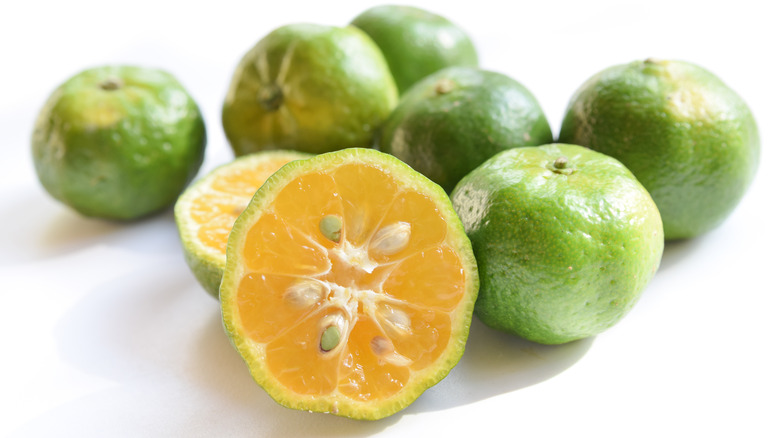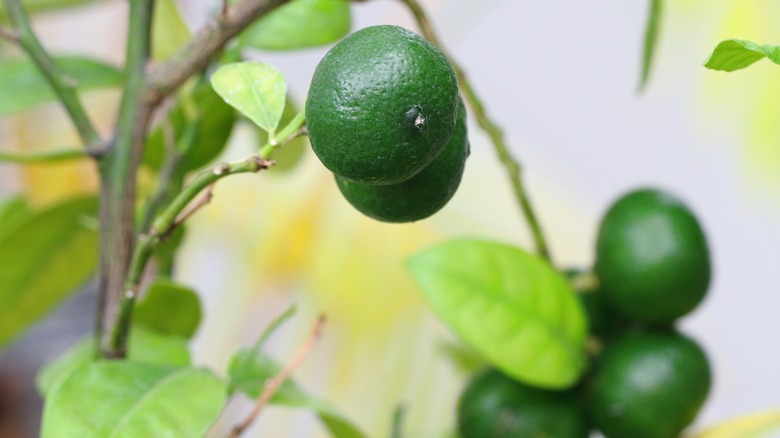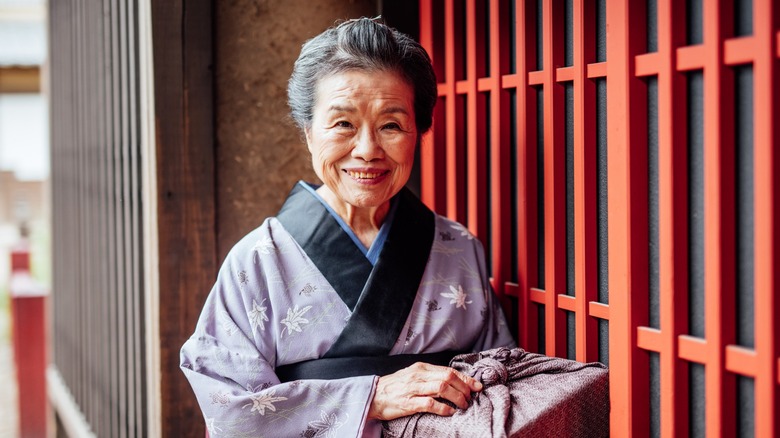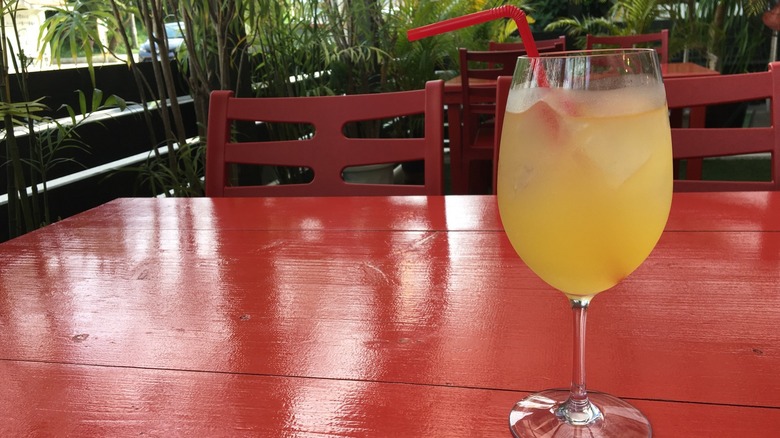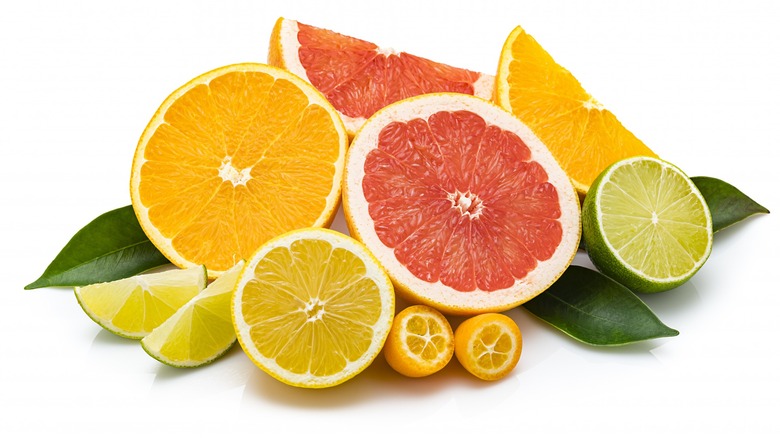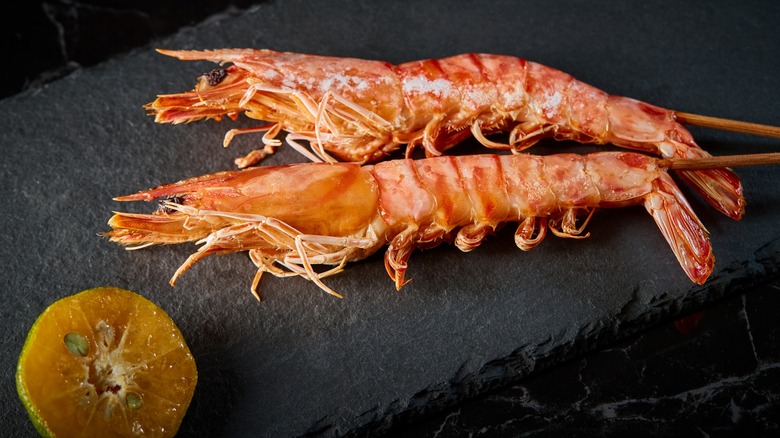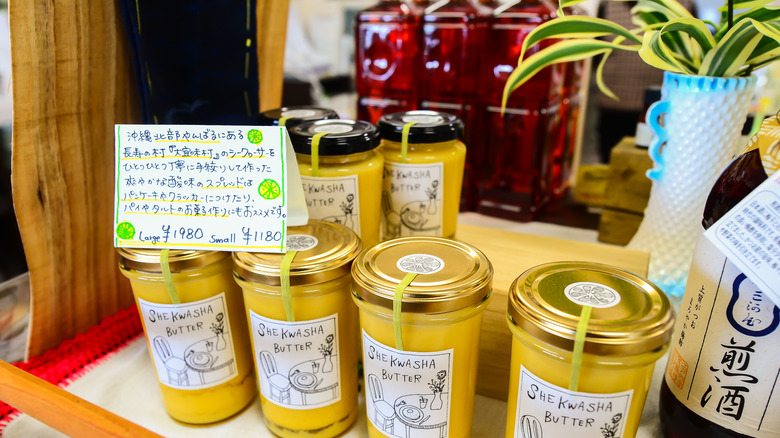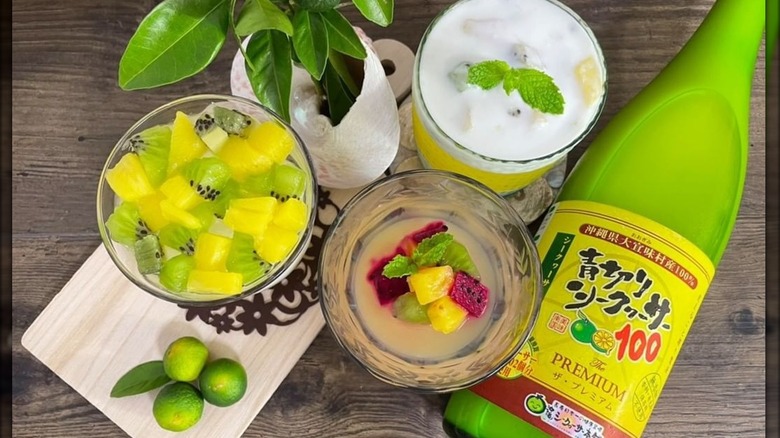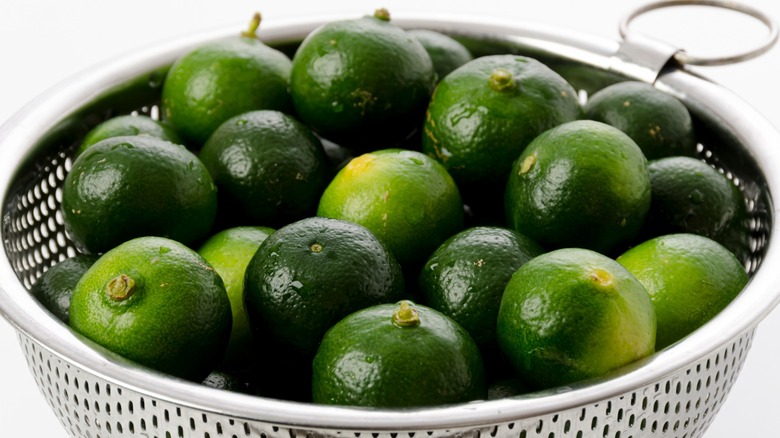Shikuwasa Is A Unique Japanese Fruit That's Best Mixed In Drinks
Relatively unknown in most of the world, the darling citrus fruit known as shikuwasa might deserve a little more attention, honestly. From the north end of Japan's Okinawa island, the diminutive fruit packs quite a wallop in terms of both flavor and nutritional value. Part of the reason that it isn't widely known is because it is only commonly grown in one place in the world, although there are now a handful of specialty citrus farms that are getting in on the action. As well, even though it outranks most other citrus with its levels of antioxidants, vitamin C, and much more, its flavor can be a bit of an acquired taste.
It looks and tastes like a cross between a lime and a tangerine but with even more sour, astringent notes. And they're tiny — tiny enough that squeezing a cup of juice might not be considered worth the effort. Even so, the brightness that just a few drops of juice adds to your water or a swanky, jet-setting cocktail might just be worth it. As adventurous consumers try more and more far-flung ingredients, they're starting to discover that there are incredible citrus flavors out there that aren't just the basic lemon, grapefruit, or orange. Shikuwasa, much like its compatriot yuzu, is an important part of Japanese culture and is beginning to make appearances over here, lucky for us. Read on to discover why and how you should get a hold of these distinctive, tiny citrus marvels.
What is shikuwasa?
As this delightful little citrus gem is available only on the north end of the main island of Okinawa, it's not something that many people have much experience with. Unless you've spent quite a lot of time in Japan, you have a serious obsession with Japanese-centric snacks, or you just want to live forever (more on that later), you may never have even heard of it. Shikuwasa looks like smaller, flatter limes on the outside but is instead a lively orange shade on the inside. The thinner skin and abundance of large seeds give shikuwasa an interesting advantage over other citrus — rather than cutting and reaming this tiny little citrus orb, you simply poke a few holes through the skin (or cut one long slit) and squeeze out the juice. Mess-free and efficient, right?
The fruit is used in a multitude of ways in Japanese culture, mostly in food, but it also has a place in cosmetics and household cleaning products, as well as finding its way into ceremonial use. Its bright, tangy flavor makes it well-suited for both sweet and savory use, with all parts of the fruit being used, from juice to peel to seeds. In Okinawa, shikuwasa is seen as one of the reasons the population ages so well for so long — packed with several times more antioxidants and flavonoids than other citrus, it's a rich part of the island's healthy living culture.
The origins of shikuwasa
If you're not a true cartophile (someone who loves maps), you might not be aware of Okinawa's location, relative to the rest of Japan. As part of an island chain, Okinawa isn't actually attached to the landmass that makes up most of the Japanese nation. Located about 400 miles south of Japan and 400 miles east of China, the Okinawa prefecture consists of a handful of islands that were a separate kingdom, known as Ryukyu, until the late 1800s. Okinawa has an even more tropical climate than the rest of Japan, rarely seeing snow. It can be compared to Hawaii's lush, humid conditions, making it a perfect home for growing fruit, particularly citrus, all year round.
Also known as one of Earth's "blue zones", where people live much longer on average, Okinawa is known for its abundance of healthy, vitamin-packed foods. Shikuwasa is one of those foods, regularly consumed alongside lots of plant-based meals and omega-rich seafood. One of the other things that Okinawans credit for their long lives is having a tight-knit group of friends and community. If that sounds more like your style than eating a salad, round up some of those friends, try out this recipe for the whiskey-based Dogs of Okinawa cocktail, and celebrate your community spirit. While the cocktail uses lime, if you can get your paws on some shikuwasa juice, we think it would be a match made in heaven.
Shikuwasa in Japanese culture
Despite its limited availability, shikuwasa has gained a solid reputation in the rest of Japan and has started to spread to other places around the world. In Japan, while it's used much like any other citrus fruit, particularly as juice or added to tea, its rarity also makes it extra special. Japanese confectionary companies love to release limited edition items that highlight the best produce of each region, and shikuwasa has found its way into snacks like Fanta soda and Kit-Kats, which were recently introduced. Because of the sour flavor, it makes a great companion to anything that already has some sweetness, making it a perfect addition to candy, ice cream, or shaved ice, which gets a healthy drizzle of sugary condensed milk before serving.
The tiny citrus is also seen as a bit of a superfood, one that contributes to the health of the people of Okinawa and has become popular throughout the rest of Japan based on that fact alone. Generally speaking, most people don't peel and eat these like you would an orange. Unless it is at peak ripeness, the juice and flesh are just too sour to use on their own, making it better suited to flavoring water or tea or including in marinades and vinaigrettes. Awamori, Japan's oldest distilled drink (also from Okinawa), is often served on ice with a squeeze of shikuwasa juice and is considered to be beneficial to your health in moderation.
What does it taste like?
As we've already mentioned, shikuwasa is quite sour unless it's at the peak stage of ripeness. When ripe, the juice can be drunk without adding anything to tame the tanginess. The rest of the time, the vibrant juice makes a terrific addition to anything that could use a little brightness or acidity. The rind of the deep green, unripe fruit is often used as a garnish because of the stunning shade as well as being highly fragrant and filled with essential oils. At that point, the rind is edible, although it's still quite astringent. Once ripe, the juice contains more natural sugars, so you'll see it added to all kinds of dishes or even served straight.
While it looks like a lime, shikuwasa is closer to a mandarin orange, but obviously without the mandarin's honeyed sweetness — think of it as a much tangier, occasionally even bitter, cousin of the mandarin, and you're getting there. Even the name of the fruit focuses solely on the flavor — shii means "sour" and kwaasaa means "something to eat" in the Okinawan dialect. You may also find the fruit and its juice called variations of the spelling such as shikwasa, shekwasa, shikuwaasaa, or even shiquasa, so keep an eye out for those if you decide to go in search of some. Once ripe, the skin turns golden and the fruit is called kugani (meaning "yellow-gold tangerine") and can now be eaten raw as the sourness is balanced by more natural sugars in the flesh.
Shikuwasa vs. other citrus
Shikuwasa can be compared to all sorts of other citrus, but it doesn't have much in common with any particular one, to be honest. It's the size and shape of a tangerine but colored like a lime; it's sour like a lemon but with a touch of mandarin-like sweetness when ripe. Often mistaken for a Phillippine calamansi because of its appearance, shikuwasa is quite a bit more bitter. When unripe, shikuwasa is about as bitter as lime but becomes something slightly sweeter once fully ripe. As for size, these fruits are fairly diminutive, often only an inch across making them more like a kumquat in size. All of these comparisons are just to say that shikuwasa is unique among citrus and can't be truly compared to anything else.
So what can you do if you're dying to try out a cocktail that calls for the juice of this hard-to-find superfood? If you can't find bottled juice in your local Asian market (it is possible, depending on where you live) or you don't want to wait for an online order, you can replicate the taste with a combination of lime and tangerine juice. If you go this route, we recommend using freshly squeezed juice for maximum flavor and a ratio of 2:1 lime to tangerine. While you won't get the nutritional benefits of the super citrus, your cocktails and smoothies will benefit from the flavor of Okinawa's tangy secret.
How to use shikuwasa
If you're lucky enough to find some shikuwasa, what can you do with this cute little fruit? Keep in mind that you're not just limited to using just the juice, either. The dried peel makes a lovely tea, while fresh zest can liven up baked goods, and the juice itself can be used nearly anywhere that you might use lime juice, like key lime pies or sorbet. For more traditional uses, the juice makes a fantastic marinade for fresh fish or yakiniku (grilled meat) or mixed into soy sauce as a dip for maki rolls or sashimi (the acidity makes a glorious companion to fattier cuts of fish like tuna). Because of the bright citrusy flavor, shikuwasa is an easy addition to cold noodles, like soba or somen, served in the heat of summer.
We think it would make a lovely compliment to gin, especially in a spring cocktail. If you've had the chance to try out some of the Japanese gins that have found their way to North America, we think the combination would be perfect. If gin isn't your thing, the sour citrus notes of shikuwasa could be muddled into a mojito or squeezed into a paloma. Again, keep in mind that these are pretty tiny little fruits, so you'll need about 30 of them to get roughly 6 tablespoons of juice. Fortunately, the juice does pack a punch, so a little goes a long way. In Japan, cocktails are sometimes garnished with a whole one speared on a toothpick, allowing the juice to slowly drip into the beverage.
Nutritional benefits
As you may have already surmised, shikuwasa isn't readily substituted with any other citrus, and this isn't just because of taste, either. Part of the reason that it's used so extensively in Japanese culture, and Okinawa in particular, is because of the stunning nutritional benefits. Shikuwasa is packed full of antioxidants, vitamin C, and flavonoids in much higher levels than most other available citrus fruits, making it a powerhouse in a tiny, sour package.
This brings us back to the idea of blue zones and why the people who eat there live longer. Okinawa is one of five blue zones on the planet, with a population that includes the longest-living women in the world — easily reaching 100 years of age with excellent physical and mental function. This part of Japan has nearly triple the amount of centenarians than those found in the US, as well as far fewer cases of dementia, cardiovascular disease, and certain types of cancer, attributed in part to their diet. Other blue zones include Sardinia, Italy; Ikaria, Greece; Loma Linda, California; and the Nicoya Peninsula, Costa Rica, all of which share diets low in saturated fats and meat but high in plants, nuts, legumes, and the occasional bit of omega-3-rich fish. Like Okinawa, the other blue zones also integrate the ideals of community, having a sense of purpose, and food as medicine into their daily lives.
Where to buy shikuwasa
Getting your hands on some of these green-skinned beauties might not be the easiest thing unless you live in (or at least very near) Japan. And even then, you might have to go searching for them if you're quite close to the island chain of Okinawa. So what can you do if you live in a small town far away from Asia? Or even worse, in a small town with no Asian market filled with everything you could ever desire? The only other option is to spend some time digging around online and see what you can find.
Several reputable Japanese snack distributors can get you a fix of shikuwasa-flavored confections if you don't mind waiting a few weeks or paying for quick shipping. Aside from that, there's one online retail giant that will always have what you need, if you know what we mean. No matter where you find your supply, make sure to read the labels (having a translation app on your phone is a lifesaver for anyone who enjoys exploring international tastes) to ensure that you're getting the real stuff. Keep in mind that it can go by many names, including the Latin one, citrus depressa, and it should, ideally, come from the Okinawa prefecture. Depending on where you are in the US, a handful of specialty growers in California will also ship you some of their homegrown shikuwasa. Finally, if you have a green thumb and live in a humid climate that receives little to no snowfall, why not order some seeds and grow your own?
Buying shikuwasa fruit vs. juice
Putting availability aside for a minute, given the choice between buying whole fruit or bottled juice, which one is a better option? If you have loads of time and don't mind squeezing, say, four dozen tiny citrus fruits, then fresh citrus is generally the best way to go. It will be fresher and have no additives, and it will give you the option to use the peel and zest in whatever recipe you're making. But again, you need a lot of fruit to get a worthwhile amount of juice. If all that poking and squeezing sounds like a bit of a drag, you might want to pick up the pre-made juice. Again, read the label to know what you're getting, like pure juice vs. a blend or the addition of sugar.
Aside from those two options, it is possible to buy shikuwasa in a couple of other formats as well. The dried peel is used for tea but can also be steeped as a way to flavor many things, including vinaigrette, marinade, or alcohol. Pick up a tube of paste to use as a simple but effective garnish or addition to any recipe — the paste can also be added to wasabi in much the same way yuzu is sometimes used. Finally, powdered shikuwasa isn't as readily available, but it does make sense if you're not sure about how much or how often you'll be using it because it will last much longer than the other forms. Keep in mind that the juice can also be frozen to retain freshness.
Storing shikuwasa
Shikuwasa stores much like other citrus fruit, but keep in mind that the thin skins can be damaged more easily and also cause the fruit to dry out a little faster than something with a hardier rind. Aside from being a little more gentle with them, you can pretty much go ahead and store them like you would any other citrus. And, of course, since we know some of the best ways to store limes, we encourage you to do just that. To start, make sure that all your fruit is in good shape before you even pile them into that bowl. Compost anything that is already too squishy, turning brown, or showing signs of mold. Even better than piling them into a bowl and leaving them on the counter? Submerge them in water or place them into a sealable plastic bag (without the water) and leave them in the refrigerator for up to 3 weeks. The moisture will help to keep them from drying out.
While some sources say that you can freeze shikuwasa whole, you might find that it takes up quite a bit of freezer space, no matter how tiny they are. A better option, if you're only going to use them for juice, is to freeze the juice in an ice cube tray and then transfer the frozen cubes to a sealable plastic bag. This should ensure a brighter flavor and a decent supply of tangy shikuwasa juice for up to six months.
